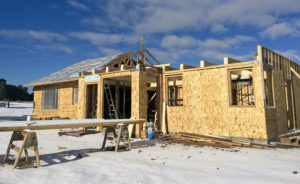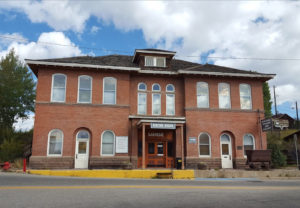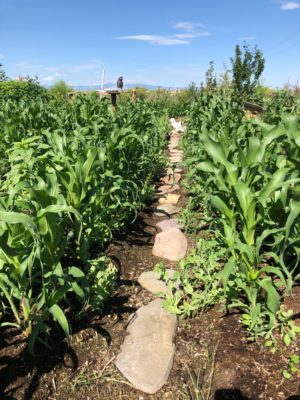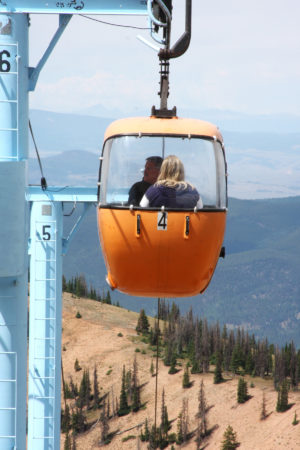By George Sibley
Said farewell to a couple of friends last week. One was an aspen – a lovely tree about thirty-five years old according to its stump, in the prime of life. After three years of increasingly evident decline, it budded this year but failed to produce any leaves. It was one of a clump of three on the south edge of our place in Gunnison; I had to take down the first one last year. I don’t hold out much hope for the remaining one, which has a thin crop of tiny leaves this year.
I think their death is related to a nasty hard fungus growing at the bases of the trees. I chisel it off, and paint some tree-wound stuff over the damaged area, but within weeks the fungus is back. I don’t use the word “evil” loosely, but I think this death-white fungus is evil – part of an alternate cancerous creation that sucks its substance from the living world. If anyone has insights on what to do about that tree fungus, my email is at the end of this article.
But this is probably part of a larger problem. We lost another aspen several years ago from the top down; the upper half of the tree simply dropped its leaves one summer, and they didn’t come back the following spring. We consulted with a woman who does garden work all over town, but she did not know what to do about either problem, and said that the aspens are troubled all over Gunnison. It is not restricted to the town.
[InContentAdTwo]
Through the early years of the 21st century, a team of Forest Service pathologists was based in Gunnison, studying Sudden Aspen Decline (SAD – and it was). Whole stands of aspen were dying in the lower altitudes of our forestlands in the Upper Gunnison. There was no smoking gun – no escalation of any known disease (like the bark beetle epidemics assaulting our conifers), no unusual parasite or predator or any of the other things that aspens generally endure stoically. I went out with the research team a couple times, and watched them dig up the roots that connect all the aspens in a clone; some of the roots were dead which meant the individual trees were losing their community.
The forest pathologists eventually concluded that climate change was the primary explanation for the die-off. The ongoing drought was a major factor in weakening the trees; but the drought itself is at least partially a consequence of the subtly rising ambient temperatures. Climatologists and other earth scientists are now suggesting we abandon drought as the descriptor for what has been going on since the turn of the century, and replace it with a word like aridification. The problem with calling the current shortfall of water a drought is that, as one climatologist said, “It allows hope to be a strategy.” As in, “Hope it ends soon like it always has; we can just wait it out.”
To call it aridification is to acknowledge that what was abnormal dryness in the 20th century may be the new normal of the 21st century; we are becoming more arid. This does not mean we won’t have big snow years occasionally; we will probably still have extreme events like the big January snows of 2017, or the miracle May a couple years earlier that salvaged an otherwise low-snow year. The backdrop to those events will be a long slow decline of surface water runoff from winter snows as ambient temperatures continue to increase, even if the amount of precipitation stays roughly the same.
This is because the warmer it gets, the more water plants will evaporate to maintain their working microclimate. This evapotranspiration starts in the headwaters’ forests, as discussed last month, but to maintain current levels of agricultural productivity more water will be required just to keep up with the evapotranspiration needs of the plants. Cities will need more electricity to maintain their artificial air-conditioned ecosystems – power generation already constitutes roughly 40 percent of all water withdrawals.
Hope, by its nature, is prerational or maybe just arational, and most of us will continue to hope in our hearts that at least some of the ongoing drought is just a nasty fluctuation in the natural cycle. Some legitimate climate model runs show a future that would be wetter as well as warmer – precipitation gains to balance the heat losses. Hope.
But that kind of hope is passive – the old hope that Father God or Mother Nature will straighten it all out and we’ll not have to do anything, except maybe accept it as a prophetic warning, and clean up our act for a while. The hard thing to accept about these changes in the climate, is that it is our act to clean up, not an act of an angry god, but just the mundane consequence of humans trying to get warm or stay cool or go to the store. What to do about that, that is active, that’s doing something to undo what’s been done?
Which brings me to last week’s farewell to another old friend – this one human. Betsy Neely is retiring from The Nature Conservancy, after 30 years with that estimable organization. Betsy’s final work has been managing TNC’s Colorado Climate Change Program, and passivity is not her way. She came to Gunnison in the depths of winter 2009, knocking on the doors of all local, state and federal agencies involved in land and resource management. In February that year, she hosted a workshop on addressing climate change, brought a team of scientists to the Upper Gunnison to bring us up to speed on what was really happening here, and to decide on a climate-related problem with which we could work.
At that time, some Central Coloradans were trying to prevent an endangered listing for the Gunnison Sage Grouse, which was in decline due to a loss of the mixed grass-and-sagebrush habitat the little birds need. Many high meadows used by the birds, and by ranchers and other wildlife, were deteriorated by gullies that lowered water tables, which gave sagebrush an edge over grasses as the meadows dried out. So improving grouse habitat (and feed for wildlife and livestock) seemed like a good project.
A lurking question at the workshop, though, was whether this was just another planning gig that would gradually starve for want of adequate and dependable funding. It wasn’t. After a couple years of planning the assault in collaboration with local land managers, public and private, Betsy was back with a significant five-year financial commitment from TNC and other granting agencies. She and her local crew launched what is now known as the Wet Meadows Project: a process of restoring once-wet high meadows that have suffered gullying, drying them out with grasses yielding to the sagebrush.
I could go on for a while about the 1,300 structures that have been built by several hundred volunteers and paid workers in eight different Upper Gunnison watersheds, to raise water tables and reunite gullied streams with their floodplains in meandering streams or sheet flows in grass. But suffice it to say here – Betsy got us doing something – conscious steps to undo some of what we’d done unconsciously.
In 2016 Betsy and TNC fulfilled the five-year commitment with a total investment, between TNC, other grantors and the land-management agencies, in the neighborhood of half a million dollars. The next year, Betsy turned the coordination of the Wet Meadows Project over to the Upper Gunnison River Water Conservancy District, a local organization, which has contracted with Tom Grant, a restoration ecologist, to carry on the project unabated, with the continued solid support of the state and federal agencies.
Yet Betsy was not quite done with us. On the eve of her retirement, in mid-July, she came back for her swan-song: a workshop to bookend her time here since the first one. The question was basically the same: Where will you go from here in tackling the challenge of a changing climate, the impacts of which you won’t entirely know until they are upon you?
This workshop was built around three strategies based on observations and findings from the past decade. First, identify and protect the refugia where the existing ecosystems will probably persist despite climate changes (including political action to sustain ranching). Second, be proactive in making systems more resilient (capable of handling whatever comes along), including management of invasives and improving water retention (more little rock structures). And third, accept and allow transformation. SAD is happening, including my aspens. But there is something particularly Betsy-like about deciding to call that “transformation.” We sound wise when we say, “Change is the only constant,” a saying I hate. But to say, “The world is ever transforming itself,” – that is different in some vital way. Accept the loss of the beautiful aspen (go upvalley to visit them), but turn ones’ energy to helping make way for the coming transformation. And learning to accept it, the first step in learning to continue loving whatever we get as maybe more than we deserve.
Thanks, Betsy, for the legacy of transformative knowledge you’ve broadcast here. Keep an eye on us.
George Sibley lives and thinks too much in Gunnison – george@gard-sibley.org




